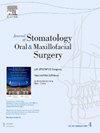Restoring form and function: The role of free dermal fat graft (FDFG) in post-parotidectomy reconstruction. A systematic review and meta-analysis of expected outcomes and patient satisfaction
IF 1.8
3区 医学
Q2 DENTISTRY, ORAL SURGERY & MEDICINE
Journal of Stomatology Oral and Maxillofacial Surgery
Pub Date : 2024-11-20
DOI:10.1016/j.jormas.2024.102162
引用次数: 0
Abstract
Purpose
This study aims to assess the outcomes of free dermal fat graft (FDFG) reconstruction following parotidectomy, evaluating both clinical complications and patient satisfaction with the procedure.
Methods
We conducted a systematic review and meta-analysis according to PRISMA guidelines, searching MEDLINE (via PubMed), Scopus, and the Cochrane Library for studies reporting on FDFG outcomes post-parotidectomy. Eligible studies included single-arm studies with data on recipient and donor site complications as well as patient satisfaction. Pooled complication rates were analyzed using a random-effects model to account for study heterogeneity.
Results
A total of 20 studies, representing 922 reconstructions in 919 patients, were included in the analysis. The overall rates of recipient site complications were low, with hematoma observed in 1.31% (95% CI: 0.50-3.34) and infection in 1.84% (95% CI: 0.95-3.53) of cases. The incidence of Frey's syndrome was 1.95% (95% CI: 0.74-5.02), and fat necrosis was noted in 1.74% (95% CI: 0.57-5.23) of patients. Donor site complications were minimal, with hematoma, infection, and seroma rates each below 1%. While there was high variability in satisfaction measures, results indicated favorable patient satisfaction with FDFG outcomes.
Conclusion
FDFG reconstruction following parotidectomy is a safe and effective method for correcting contour deformities, showing minimal complications and high patient satisfaction. The low incidence of complications, including Frey's syndrome, underscores FDFG as a viable option for facial contour restoration in parotid surgery, providing favorable aesthetic and functional outcomes.
恢复形态和功能:游离真皮脂肪移植(FDFG)在腮腺切除术后重建中的作用。对预期效果和患者满意度的系统回顾和荟萃分析。
目的:本研究旨在评估腮腺切除术后游离真皮脂肪移植(FDFG)重建的效果,同时评估临床并发症和患者对手术的满意度:我们根据PRISMA指南进行了系统性回顾和荟萃分析,检索了MEDLINE(通过PubMed)、Scopus和Cochrane图书馆中有关腮腺切除术后游离真皮脂肪移植效果的研究报告。符合条件的研究包括具有受体和供体部位并发症以及患者满意度数据的单臂研究。采用随机效应模型对汇总的并发症发生率进行分析,以考虑研究的异质性:共有20项研究被纳入分析,代表了919名患者的922次重建。受体部位并发症的总体发生率较低,血肿发生率为1.31%(95% CI:0.50-3.34),感染发生率为1.84%(95% CI:0.95-3.53)。弗雷氏综合征的发生率为 1.95% (95% CI: 0.74-5.02),1.74%(95% CI:0.57-5.23)的患者出现脂肪坏死。供体部位并发症极少,血肿、感染和血清肿的发生率均低于 1%。虽然满意度的测量结果差异很大,但结果显示患者对FDFG的效果非常满意:结论:腮腺切除术后的FDFG重建是一种安全有效的轮廓畸形矫正方法,并发症少,患者满意度高。包括 Frey's 综合征在内的并发症发生率很低,这突出表明 FDFG 是腮腺手术中面部轮廓修复的一种可行方法,可提供良好的美学和功能效果。
本文章由计算机程序翻译,如有差异,请以英文原文为准。
求助全文
约1分钟内获得全文
求助全文
来源期刊

Journal of Stomatology Oral and Maxillofacial Surgery
Surgery, Dentistry, Oral Surgery and Medicine, Otorhinolaryngology and Facial Plastic Surgery
CiteScore
2.30
自引率
9.10%
发文量
0
审稿时长
23 days
 求助内容:
求助内容: 应助结果提醒方式:
应助结果提醒方式:


